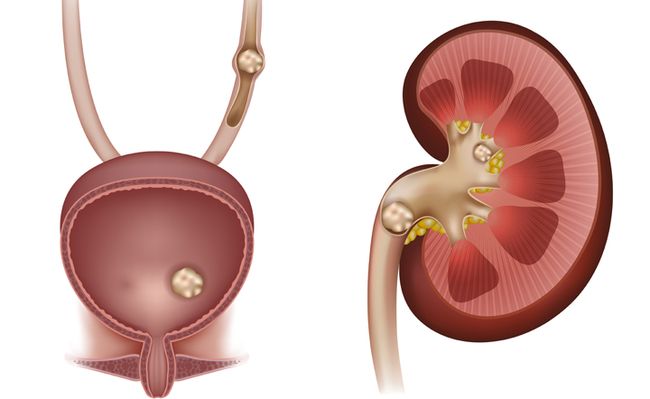Why does blood appear in the urine in women and how dangerous is it?
Many women of reproductive age sometimes find blood in their urine. This phenomenon is called hematuria and indicates a malfunction in the body of a woman. If hematuria is accompanied by burning in the lower abdomen and during urination, back pain, then the woman has diseases of the excretory system, such as cystitis, inflammation of the kidneys, etc. The appearance of blood without any discomfort is often a symptom of bladder cancer. This probability increases significantly if a woman has already crossed the forty-year milestone. In any case, if blood appears in the urine, you should immediately consult a doctor.
There are two types of hematuria - macro- and microhematuria. In the first case, the blood is visible to the naked eye, in the second it can only be detected under a microscope in a laboratory study. Normal urine should be clear, light yellow. If it is cloudy or has an unpleasant pungent odor, this may indicate microhematuria and inflammatory processes.
Hematuria (blood in the urine in women) is a signal that some kind of malfunction has occurred in the body.
Causes of blood in the urine
Currently, medicine knows more than a hundred diseases that cause blood in the urine in women. Not all of them are dangerous, but a timely visit to a doctor will help to avoid problems with the excretory system in the future. Most often, women are faced with such diseases that lead to hematuria, such as cystitis, microliths in the kidneys, inflammation, pathology and oncological formations. Such consequences are metabolic disorders, poor personal hygiene, hypothermia, alcohol abuse, malnutrition, excessive physical activity. Also a significant role is played by hereditary predisposition and timely examination by a doctor.
Urolithiasis disease
Sometimes microliths are formed in the kidneys - stones and the so-called sand, which may not make themselves felt for a long time. Often, after physical exertion, sports, intense back massage, women develop pulling pains in the lower back, urine becomes reddish or brownish in color. Typically, such hematuria is accompanied by severe pain in the lumbar region - renal colic, which is caused by the movement of microliths along the ureter and trauma to the blood vessels. In addition to pain and blood loss, urolithiasis can lead to severe inflammation and kidney failure, and therefore requires urgent treatment.
 Kidney stones can lead to blood in the urine
Kidney stones can lead to blood in the urine Treatment is usually physiotherapy, if this fails, the microliths are surgically removed.
Cystitis
This is a common disease in women, which can occur as a result of infection in the urethra, hypothermia and overwork. If the cystitis is hemorrhagic, there may be traces of blood in the urine. In this case, it is usually painful for a woman to write, there are cutting pains in the lower abdomen, frequent urge to urinate even with an empty bladder. Also, the disease is characterized by general malaise. Launched cystitis can cause inflammation of the kidneys, so you can’t let it take its course.
Cystitis is usually treated with anti-inflammatory drugs.
Oncological diseases
The main danger of oncological diseases is that they are asymptomatic for a long time. Urine with blood clots often indicates that metastases have begun to destroy blood vessels in the tissues. If the clots are worm-shaped and dark in color, this most likely indicates kidney cancer. At the same time, the patient does not experience any unpleasant sensations and often does not attach much importance to
Cancer of the kidneys and bladder is treated promptly, in some cases chemotherapy alone can be dispensed with. Naturally, the chances of a favorable outcome are higher with early diagnosis of the disease.
Inflammation of the kidneys and other inflammatory diseases
With strong inflammatory processes of the excretory system, there is often a violation of the integrity of the vessels, as a result of which blood appears in the urine. As a rule, brightly colored urine, high fever, chills and back pain, signs of severe intoxication and swelling of the extremities are signs of advanced kidney inflammation.
Inflammation is treated with antibiotics and anti-inflammatory drugs.
 Inflammatory processes violate the integrity of blood vessels, which leads to the appearance of blood in urine
Inflammatory processes violate the integrity of blood vessels, which leads to the appearance of blood in urine Injuries
Blood may appear in the urine after an injury to the excretory system, such as a blow or a fall. A bruise is usually accompanied by pain. Often, red blood cells in the urine appear after medical procedures, such as inserting a catheter into the urethra.
Treatment depends on the nature and severity of the injury. Minor injuries and bruises go away on their own, and a kidney rupture, for example, requires immediate surgical intervention.
Hormonal drugs
Oral contraceptives make the blood thicker and the blood vessels brittle, which can cause occasional hematuria. This phenomenon is usually temporary and does not cause any discomfort to the woman, but is not the norm.
A woman needs to contact a urologist to confirm the diagnosis, and then to a gynecologist to choose other pills or another type of contraception. Usually, additional treatment is not required, hematuria disappears soon after cessation of hormonal drugs. To strengthen the walls of blood vessels, a woman is shown taking vitamin complexes containing vitamin C.
 Hormonal drugs can lead to the appearance of blood in urine
Hormonal drugs can lead to the appearance of blood in urine Bladder endometriosis
This disease is the result of advanced endometriosis, in which endometrial cells inside the uterus grow and penetrate into neighboring organs. During critical days, they begin to flake off and bleed, wherever they are. Bladder endometriosis may not cause much discomfort on ordinary days, but during menstruation it causes severe pain, hematuria, and can make it difficult to urinate.
Treatment of this disease begins with a visit to the gynecologist and the appointment of drugs (most often hormonal and anti-inflammatory drugs). In especially advanced cases, overgrown endometrial cells are removed promptly.
Hematuria during pregnancy
Blood is often observed when urinating in women who are expecting a baby. In most cases, blood appears in the last stages of pregnancy and is not something dangerous. The developing fetus and the enlarged uterus compress the internal organs, in particular the kidneys and bladder, causing microtrauma. This phenomenon looks alarming, but does not harm either the woman or the child. The expectant mother is advised to spend more time in a calm state and not overwork. In some cases, pregnancy can reveal pathological kidney diseases that were invisible before the conception of the child.
Treatment is not required if the woman is healthy and the pregnancy is well tolerated. If urine with blood is observed almost daily, the doctor prescribes hemostatic drugs, since anemia during pregnancy is extremely dangerous.
 In pregnant women in the later stages, blood in the urine is often observed, which is not a dangerous symptom.
In pregnant women in the later stages, blood in the urine is often observed, which is not a dangerous symptom. Errors in the collection of analyzes
It is important to remember that there are foods and substances that can turn urine reddish, but do not interfere with the excretory system. So, the use of beets in large quantities can give urine a reddish tint. Some women donate urine for analysis during critical days, not taking into account the ingress of menstrual blood. Also, urine collection after childbirth must be carried out through a catheter to avoid blood from entering the vagina.
Important! If you find blood in your urine, in no case do not start treatment with folk remedies, but immediately consult a doctor.
To avoid hematuria for a healthy woman, you need to take care of yourself and adhere to the following rules:
- avoid hypothermia;
- observe the rules of personal hygiene;
- not to be subjected to strong physical exertion and not to lift weights;
- stick to proper nutrition.




